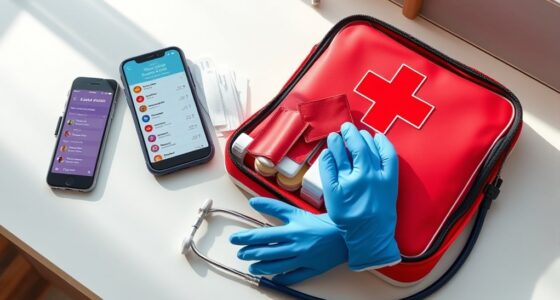To prepare an emergency communication plan, start by defining clear protocols that include multiple communication methods like phone trees, emails, and messaging apps. Identify all key stakeholders, clarify their roles, and establish a chain of command to avoid confusion. Keep contact lists updated and accessible, and create simple, consistent messages tailored for different emergencies. Regularly review and improve your plan based on drills and feedback—continuing will help you master these essential steps.
Key Takeaways
- Establish clear communication protocols, including contact points, message templates, and escalation procedures.
- Identify and engage all relevant stakeholders, defining roles and responsibilities for effective coordination.
- Develop and maintain an up-to-date contact list with emergency contacts and chain of command information.
- Ensure message clarity and consistency, using simple language and addressing accessibility needs.
- Regularly review, test, and update the plan to incorporate new technologies and feedback for continuous improvement.

In an emergency, clear and reliable communication can make all the difference. When disaster strikes, your ability to relay accurate information swiftly and efficiently is essential for coordinating responses and minimizing damage. That’s why establishing well-defined communication protocols beforehand is indispensable. These protocols serve as a structured roadmap, ensuring everyone involved knows exactly how to communicate, who to contact, and what steps to follow. By creating standardized procedures, you reduce confusion and prevent critical information from falling through the cracks during chaos. Incorporate redundant methods, such as phone trees, emails, and messaging apps, to guarantee communication remains intact even if some channels fail. Having a clear communication hierarchy**** helps streamline decision-making and clarifies responsibilities during emergencies.
Stakeholder coordination is another key element in your emergency communication plan. You need to identify and engage all relevant parties—employees, emergency responders, local authorities, and even community members—so everyone is on the same page when an incident occurs. Establishing clear roles and responsibilities for each stakeholder helps streamline the response efforts. For instance, designate who will provide updates, who manages media inquiries, and who makes essential decisions. Regular drills and training sessions are fundamental to ensuring these stakeholders understand their roles, fostering trust and efficiency during actual emergencies.
Effective emergency response depends on clear stakeholder roles and regular training to ensure coordinated action.
Your plan should also include a detailed contact list that’s regularly updated, including emergency contacts, key personnel, and external agencies. Make sure this list is accessible in multiple formats—digital and hard copies—and stored in secure, easily accessible locations. Developing a communication hierarchy can further clarify the chain of command, helping to prevent conflicting messages or delays. When everyone knows who to turn to for specific issues, the flow of information remains smooth and organized.
Additionally, consider the importance of communication clarity. Use simple, unambiguous language to avoid misunderstandings. During high-stress situations, complex jargon or vague instructions can lead to errors or delays. Incorporate templates for messages that can be quickly adapted to various scenarios, ensuring consistency and accuracy in your communication. Also, plan for language barriers or accessibility needs, making sure your messages reach all stakeholders effectively.
Finally, always review and update your emergency communication plan regularly. Situations evolve, new stakeholders may emerge, and technology advances. Regular audits and feedback sessions will help you identify gaps and improve your protocols. By investing time into meticulous planning, you’ll be better prepared to respond confidently and cohesively when an emergency occurs. Ultimately, a well-crafted communication plan empowers you to act swiftly, coordinate seamlessly, and protect everyone involved.
Frequently Asked Questions
How Often Should the Emergency Communication Plan Be Reviewed?
You should review your emergency communication plan at least annually to guarantee it’s current and effective. Regular plan updates help incorporate new contact information, technology, or procedures. Additionally, conduct staff training after each review to reinforce roles and responsibilities. This proactive approach ensures everyone stays prepared and confident during emergencies, minimizing confusion and delays when it matters most. Stay vigilant with your plan updates and staff training to maintain readiness.
What Tools Are Most Effective for Emergency Communication?
You should use reliable tools like satellite phones and emergency radios for effective communication during crises. Satellite phones work well in remote areas where cell service is unreliable, ensuring you stay connected. Emergency radios are vital for receiving alerts and updates, especially during power outages. Combining these tools enhances your communication resilience, keeping you informed and able to coordinate responses quickly and efficiently in any emergency situation.
How to Include Non-Digital Communication Methods?
You should never underestimate the power of traditional methods in a crisis! Incorporate analog communication like landline phones, printed notices, and walkie-talkies to reach everyone when digital fails. Keep a physical emergency contact list, use loudspeakers for announcements, and post flyers in common areas. These tried-and-true methods guarantee essential messages get through, even when technology is down, making your plan resilient and foolproof.
Who Should Be Designated as Emergency Communication Coordinators?
You should designate individuals as emergency communication coordinators who understand your communication hierarchy and can act swiftly. These designated contacts are responsible for managing information flow, coordinating with emergency services, and making sure everyone stays informed. Make certain they’re easily accessible and trained on your plan. Clearly define their roles within the communication hierarchy to streamline decision-making and ensure reliable, timely updates during crises.
How to Ensure Communication Plans Are Accessible to All?
A chain is only as strong as its weakest link, so make sure your communication plans are accessible to everyone. You should provide materials in multiple languages, consider cultural differences, and use clear, simple language. Make these plans available in various formats—print, digital, and visual cues—and distribute them widely. Regularly review and update to accommodate changing needs, ensuring all community members understand and can act in emergencies.
Conclusion
By now, you’ve seen how a solid emergency communication plan can save lives. Some say that in a crisis, information spreads faster than fire, making quick, clear messaging vital. While the theory that communication alone can prevent chaos isn’t entirely true, it’s undeniable that being prepared helps you stay calm and organized. Remember, your plan isn’t just words—it’s your lifeline. Take action today, and turn uncertainty into confidence when it matters most.









